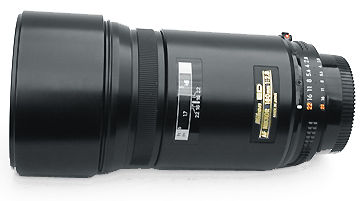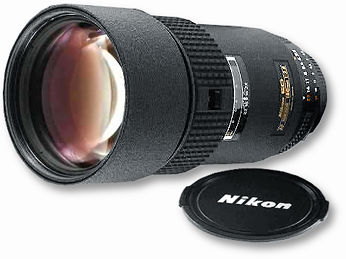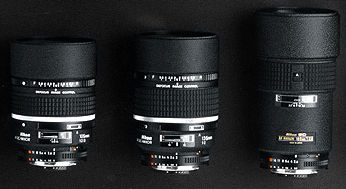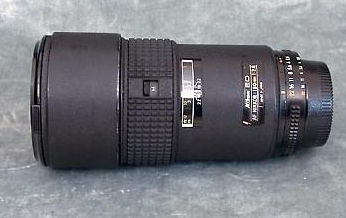UPDATE NOTICE: I Have updated the AF 180mm f/2.8 IF ED lens group into three sections; you may CLICK HERE to the new site
In September, 1986, Nikon
quietly introduced an autofocus version of the famed MF Nikkor 180mm f/2.8s ED lense, it was among the first initial
batch of the first generation autofocus Nikkor lenses . Instead of taking a easy
path of just upgrading the manual focus direct to autofocus, Nikon upgraded the AF
lens with an entirely different optical formula in a more complex 8 elements in 6
groups design as opposed to the manual focus optical construction of 5 elements in
4 group design used in the MF lens. One significant difference found in the AF lens
was the adoption of an internal focus design. Unfortunately, very few photographers
noticed its presence - primarily because consumers interest has shifted towards high
performance zoom lenses such as the popular AF-Nikkor Zoom 80-200mm f/2.8
ED. Also COMPARE this
with the NEWER series of autofocus AF Nikkor 180mm lens group.
 |
Another reason for its poor reception was also partly due to the physical appearance and design of the original batch of Nikkor optic. They have a a strong plasticy presence in their overall exterior design and users were quite deceptive to such "new" Nikkor feel and look. One area was also heavily criticized was its narrow (1/2") manual focusing grip on the lens, mainly due performance of early Nikon AF SLRs were still at its infantries stage. |
The untimely debut of the lens (much due to skeptical commitment to early AF SLR camera models such as F301, F501, F401 and not until the more serious F-801/F4 was eventually being introduced in a late 1988) and poor human engineering, users' interface of the lens design was generally regarded as main factors which also greatly affected anticipation of supposedly rapid development of AF Nikon SLR photography. Anyway, as far as interface of lens design is concerned, it was either a love or hate relationship but unfortunately, in this situation there were more negative reviews than positive and eventually Nikon has to revamp the exterior appearance of entire series of their AF Nikkor lenses. Critical areas such as the narrow strip of focusing ring has been redesigned with a rubberized ring which was more closely resembled a traditional Nikkor look, while the manual focusing ring was broaden to provide firmer grip during manual focusing.
 |
That was not all Nikon can offer, the revised design of the AF 180mm f/2.8s ED IF lens was also being designed with a all wrapped crinkle finishes which has a strong industrial look. However, despite all those effort made to the lens, it is still exhibiting a very fragile feel with its light weight. Personally, I thought I should take another good look again at the 180mm lens to replace my 10 years' old manual focus Nikkor; I was immediately put off by the first impression of the lens. |
I think it has a lot to do with the poor selection of material used for the focusing ring where the cheap feel of artificial rubberized focusing ring was the main cause to project such a negative thought for the lens. The weight of the AF lens was reduced to 750g as compared to 880g found in the manual focus version. Although I know that has nothing to do with its excellent optical quality that it may prevail (where many users felt it is also one hell of an Nikkor telephoto lens), but when come to think of it, it was such a pity to realize my halfhearted attempt to look for an upgrade was actually caused by an negative first impression; I could not hide my disappointment and decide to hold back the decision for a upgrade. Well, I just don't understand why Nikon took so long to understand how consumers feel and interpret quality issue in their camera and lenses and next - why is it so difficult to restore the excellent Nikkor physical feel in the general series* of the AF Nikkor lenses.
 |
Physical comparison among the two bulkier DC-Nikkor lenses in shorter focal length of 105mm & 135mm and each comes with a larger f/2.0 maximum aperture makes the AF-Nikkor 180mm f/2.8D EDIF lens looks moderate in its size. Thus, it can also be very appealing especially for those photographers who are looking for compromise on fast lens speed and high portability. |
So, in 1994, the AF Nikkor 180mm f/2.8 EDIF was revised again with another D-lens chips upgrade. Optically, there is not distinctive differences between the versions. All the three series also have Internal focus (IF) design. Except I have heard about Nikon did shorten the focusing arc from infinity to its closest focusing distance in order to speed up AF operation with the newer series. However, optical construction for the three generations of the AF Nikkor 180mm remain as 8 elements in 6 groups design and even the current AF Nikkor 180mm lens group with the distance chip set is still employing a similar optical formula.
 |
Externally, the only way you can distinguish the two version of newer and older 180mm AF Nikkor is by locating an extra golden "D" alphabet after the lens designation plate where it reads " Nikkor ED AF Nikkor 180mm 1:2.8 D. |
As a guide line, the first
generation of the 180mm with the narrow focusing ring started from 200001, the first
upgrade with non-D version was started from 250001, based on most of the serial numbers
appeared for lenses with distance chipset installed are started from 4xxxxxxxx (IF
you have a lens with differing starting serial number, please update Roland
Vink with the
info). Technically, other than providing better compatibility in various sophisticated
metering systems used in more advance Nikon SLR models to include distance information
for computation of metering accuracy; current series with distance chip set incorporated
may fetch a higher premium as used item than previous versions. So,if you are shopping
for a used unit, this is one area you may take a note to identify the version you
are purchasing.
 |
Optically, most users of AF 180mm Nikkor lens I have talked to have no complaint. In fact, a user who claimed owning both Nikkor MF and AF lenses felt the newer AF series have more "bites" than the MF series especially performance at the few wide opened maximum apertures. |
Most users felt AF lenses have helped them to become more responsive in handling their photography. I won't question such remarks as telephotography has greatly benefited from the implementation of autofocus technology which has absolute advantage and far superior in handling action photography. As a good friend of mine who works as a photo editor in a popular local daily commented, " I have been in the business for the last 30 years, I have been through stages of using mechanical F2 Nikons, the electronic Nikon F3 but autofocus is indeed a fabulous feature for journalists like us especially for covering fast pace news and sports events... those days, we have to preset and anticipate path of action and manually prefocus to anticipate a possible moment while success rate depends a great deal on luck too too - autofocus (and various electronic gadgets found in the camera section) changes everything of how we work and even the way how we prepare a possible shooting session on the field ... ".
Well, he shoots
and handles more photography with his AF SLRs and lenses than me, he should be right.
|
Nikkor
180mm
f/2.8s ED |
Nikkor 200mm f/3.5s ED IF |
Nikkor
200mm
f/4.0s |
Nikkor
200mm
f/2.0s ED IF |
| Back to MAIN INDEX PAGE of 180mm/200mm Nikkor lenses | COMPARE this with newer series of the autofocus AF Nikkor 180mm lens group
| Message Board |
for your
Nikkor
Optics
in a shared environment
| Message Board | Specifically for Dispose or Looking for new/used Nikon/Nikkor photographic equipment
| Nippon Kogaku Rangefinder Resources | Nikon F | Nikon F2 | Nikon F3 | Nikon F4 | Nikon F5 | Nikon F6 | Nikkormat / Nikomat | Nikon FM Series | Nikon FE/ FA | Nikon EM/FG/FG20 | Nikon Digital SLRs | Nikon - Other models |
Nikon MF RF-Nikkor lenses for Rangefinder
cameras:-
Main Index Page
Nikon
Auto Focus Nikkor lenses:- Main
Index Page
Nikon
Manual
Focus
Nikkor lenses:-
Fisheye-Nikkor Lenses - Circular |
Full Frame |
Ultrawides Lenses - 13mm15mm18mm20mm |
Wideangle Lenses - 24mm28mm35mm |
Standard Lenses - 45mm 50mm 58mm | Telephoto Lenses
- 85mm105mm135mm180mm & 200mm |
Super-Telephoto Lenses - 300mm 400mm 500mm 600mm 800mm 1200mm |
 |
Special Application
lenses: Micro-Nikkor Lenses - 50mm~55mm -60mm 85mm -105mm 200mm Micro-Zoom 70-180mm Perspective Control (PC) - 28mm 35mm PC-Micro 85mm Dedicated Lenses for Nikon F3AF: AF 80mm f/2.8 | AF 200mm f/3.5 EDIF Depth of Field Control (DC): 105mm 135mm Medical Nikkor: 120mm 200mm Reflex-Nikkor Lenses - 500mm 1000mm 2000mm Others: Noct Nikkor | OP-Nikkor | UV Nikkor 55mm 105mm | Focusing Units | Bellows-Nikkor 105mm 135mm Nikon Series E Lenses: 28mm35mm50mm100mm135mm | E-Series Zoom lenses: 36~72mm75~150mm70~210mm |
MF Zoom-Nikkor Lenses: 25~50mm | 28~45mm | 28~50mm | 28~85mm | 35~70mm | 36~72mm E | 35~85mm | 35~105mm | 35~135mm | 35~200mm | 43~86mm | 50~135mm | 50~300mm | 70~210mm E | 75~150mm E | 80~200mm | 85~250mm | 100~300mm | 180~600mm | 200~400mm | 200~600mm | 360~1200mm | 1200~1700mm
Tele-Converters: TC-1 | TC-2 | TC-200 | TC-201 | TC-300 | TC-301 | TC-14 | TC-14A | TC-14B | TC-14C | TC-14E | TC-16 | TC-16A | TC-20E
Recommended links to understand more technical details
related to the Nikkor F-mount and production Serial Number:
http://rick_oleson.tripod.com/index-153.html by: my
friend, Rick Oleson
http://www.zi.ku.dk/personal/lhhansen/photo/fmount.htm by: Hansen,
Lars Holst
http://www.mir.com.my/rb/photography/hardwares/nikonfmount/lens2.htm
http://www.photosynthesis.co.nz/nikon/serialno.html
Recommended Reading Reference on Nikon cameras and Nikkor lenses | about this photographic web site
| | Back | Main Index Page of Nikkor Resources | Back | Main Index Page of Pictorial History of Nikon SLRs |
| Home - Photography in Malaysia |
![]() Co-developed
with my web buddy, Rick Oleson® &
Co-developed
with my web buddy, Rick Oleson® & ![]() Denmark, Creator of the Nikon
Repair Group Mailing-List;
A
contributing effort to Michael Liu's Classic Nikon SLRs and
Nikkor optic site.
Denmark, Creator of the Nikon
Repair Group Mailing-List;
A
contributing effort to Michael Liu's Classic Nikon SLRs and
Nikkor optic site.
Credit: MCLau®, who has helped to rewrite
some of the content appeared this site. Chuck Hester® who has been helping
me all along with the development of all these Nikon websites; Lars Holst Hansen, 'Hawkeye'
who shares the same passion I have; Ms Rissa, Sales manager
from Nikon Corporation Malaysia for granting permission to use some of the official
content; Ted Wengelaar, Holland
who
has helped to provide many useful input relating to older Nikkor lenses; Some of the references
on production serial numbers used in this site were extracted from Roland Vink's website; Hiura Shinsaku from Nikomat
Club Japan. Lastly,
to all the good people who has contributed their own expeience, resources or kind
enough granted permission to use their images of their respective optic in this site.
It is also a site to remember a long
lost friend
on the Net. Note:certain content and
images appeared in this site were either scanned from official marketing leaflets
& brochures published by Nikon and/or contribution from surfers who claimed originality
of their work for educational purposes. The creator of the site will not be responsible
for may discrepancies arise from such dispute except rectifying them after verification. "Nikon", "Nikkormat", "Nippon Kokagu
KK"
& "Nikkor" are registered
tradename of Nikon Corporation Inc., Japan. Site made with an Apple IMac.



